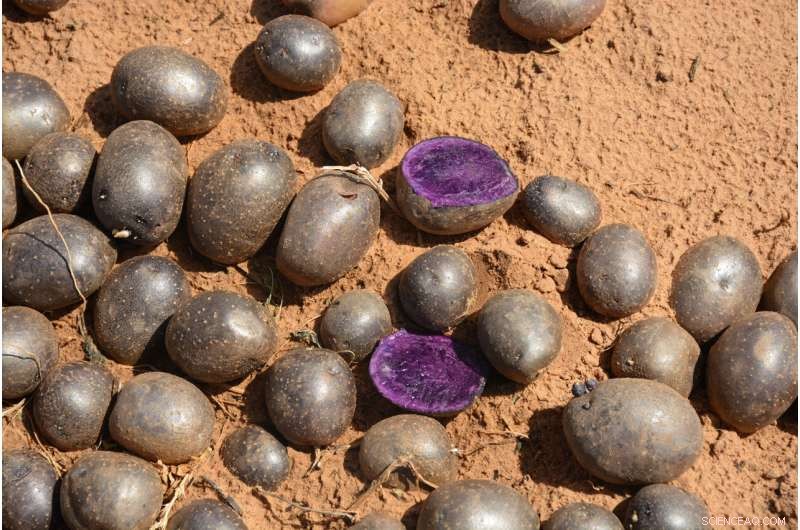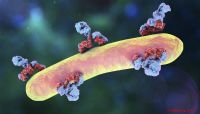Kartoffelforædlingsprogram retter sig mod pommes frites, chipping, friske markeder

En lilla-kød kartoffel er en af de unikke kloner, Texas A&M AgriLife kartoffel avlsprogram dyrker i markforsøg nær Springlake. Kredit:Texas A&M AgriLife foto af Kay Ledbetter
Nye kartoffelsorter opdrættet af Texas A&M Potato Breeding Program kan komme ind på pommes fritesmarkedet inden længe, sagde Isabel Vales, Ph.D., Texas A&M AgriLife kartoffelavler i Department of Horticultural Sciences i Texas A&M College of Agriculture and Life Sciences .
På en nylig markdag i det sydlige højsletter nær Springlake diskuterede Vales de seneste kartoffelkloner, som forædlingsprogrammet er kommet gennem pipelinen.
"Vi er ret begejstrede for en let rødbrun eksperimentel kartoffelklon, der har en meget speciel egenskab:en høj procentdel af stivelse og høj tyngdekraft selv under de meget stressende høje temperaturforhold i Texas," sagde Vales. "Jeg tror, at markedet for forarbejdning af pommes frites, for hvilket Texas ikke har frigivet nogen forarbejdningsrusser, er en mulighed."
Kartoflens eksperimentelle identifikation er COTX08063-2Ru. Det første kryds blev lavet i Colorado, og udvælgelsen i Texas.
Historisk set har Texas ikke været en spiller på det pommes fritesmarked, sagde Vales, primært på grund af den hårde konkurrence fra det nordvestlige, som er virkelig stærk på det marked.
"Men også i Texas kan vi ikke få de høje faststoffer, der kræves til forarbejdningsmarkederne. Ud af alle de varianter og eksperimentelle kloner, vi evaluerede over tid, havde ingen af dem en høj tyngdekraft," sagde Vales. "Den eksperimentelle klon COTX08063-2Ru har en høj vægtfylde, selv under høje varmestressforhold i Texas, og laver meget gode pommes frites. Det er andet år, denne klon er med i de nationale franske yngelkartoffelforsøg."
Hun sagde, at mængden af stivelse i kartoffelknolde er den vigtigste faktor, der bestemmer en kartoffels brug. Høje faste stoffer eller tyngdekraft betyder, at kartoflerne er faste og tætte. Kartoffeludbyttet er højt, ligesom det stivelsesholdige stof. Kartofler med høj stivelse bruges ofte til at lave forarbejdede fødevarer såsom pommes frites, chips og dehydrerede kartofler. Potatoes with low to medium starch levels are frequently used for the fresh or table stock market.
Collaborating across state lines to reach numerous markets
Vales said the Texas A&M Potato Breeding Program is part of the Southwestern Regional Potato Cultivar Development Project, a multi-state project funded by the U.S. Department of Agriculture National Institute of Food and Agriculture.
"The Southwestern program was established in 1997, and we are celebrating 25 years of successful collaborative work," she said.
In the U.S., Vales explained, there are four regional potato variety development groups involving 12 breeding programs in public land-grant universities and others within the USDA Agricultural Research Service. The regions are Northwestern—Washington, Oregon and Idaho; North Central—North Dakota, Wisconsin, Minnesota and Michigan; Northeastern—North Carolina, New York, Maine and Florida; and Southwestern—Texas, Colorado and California.
"In the southwestern region, we don't have a USDA-ARS contribution like the others do," she said.
Texas A&M University, Colorado State University and the University of California at Davis initiated the Southwestern Regional Potato Cultivar Development Project to meet the unique needs of the region's potato industry, Vales said.
Crosses and original selections are made in Colorado and Texas, followed by regional evaluation trials in all three states and additional states in the western region—Oregon, Idaho and Washington. Some french fry and chipping clones enter national trials every year.
"In the U.S., most potato breeding programs are public," Vales said. "The level of cooperation in potato breeding is unparalleled; potatoes developed by the Southwestern program are planted all over the U.S. and Canada. In the Southwestern region, we also evaluate potatoes developed by other regional programs."
She added that while federal funding is the program's main source for public breeding, other funds come from state departments of agriculture, national commodity groups like Potatoes U.S., foundations and in-kind support from growers. Additional funding comes from royalties derived from varieties released under plant variety protection, PVP, by the Texas A&M program.
"To obtain PVP, we have to declare that the potato varieties are unique, distinct and stable," Vales said. "Seed growers planting PVP varieties must pay royalties. Texas A&M has been very successful in that regard. The amount we received this past year is more than $900,000, and part of that is reinvested in the program."
Field day events introduce Texas A&M varieties, open market outlets
Vales said the trials in various locations across the state and field days are the best way to let growers and the industry know about the latest potato clones in the breeding pipeline.
"This year, we had 180 different clones in the field day display, representing fresh and processing market classes," she said. "Within the processing class, we had chippers and french fry types; within the fresh, we had reds, yellows, purples, smalls and fingerlings."
Around 48 people from various U.S. states and Canada attended the Springlake event. The attendees expressed interest in some clones and shared priorities and challenges with the Texas A&M Potato Breeding Team and other participants.
Early and advanced selected clones included in the field day are also evaluated in agronomic trials in Dalhart and the San Luis Valley, Colorado, as well as California around Bakersfield, South Central Valley and Tulelake, near the Oregon border.
Southwest region presents unique growing conditions, challenges for potatoes
She indicated that cooler nights favor higher yields and fewer tuber defects. Thus, in Texas, the yields get higher with elevation and latitude, which means "we typically obtain much higher yields and better tuber quality out of the Dalhart trials located in the Texas Panhandle."
High temperature during the growing season is a major abiotic stress in several of the Southwestern Region production areas, Vales said. Heat stress can trigger physiological defects and negatively affect tuber yield and quality. Sensitivity to internal tuber heat necrosis, growth cracks, reducing sugar build-up, brown center, hollow heart and heat sprouts are assessed from field-harvested tubers.
"The potato varieties we develop come in different tuber sizes, shapes, skin and flesh textures and colors that fit different market needs," Vales said. "For instance, we collaborate with Tasteful Selections, looking for clones with many small tubers. We are also growing fingerlings and bi-color potatoes. Recently, we developed a round russet with pink eyes and yellow flesh that was provided an exclusive release to explore new market opportunities."
The Texas A&M Norkotah Russet strains continue to be the most popular, with 35 licensees in 12 states, she said. These are fresh-market russets. Two other fresh-market russets growing in popularity are the Reveille Russet, which doubled acreage from 2020 to 2021, and Vanguard Russet. The heat tolerance and long dormancy of Reveille Russet and Vanguard Russet are attractive features to growers across the U.S. and Canada.
Expanding potato markets beyond the Southwestern Region
Potato entries are evaluated in each state's trials for numerous traits, including chip and french fry quality, Vales said. Top entries move to Southwestern for two years and Western Regional Trials for up to three years. Superior clones are released as new varieties. Also, Colorado, Texas and California participate in National Chip Processing Trials and the National Fry Processors Trials. Advanced selections are also sent to collaborators all over the U.S. and Canada.
Vales said the Southwestern Region Project shares breeding stocks and advanced selections with a dozen other states. Since the inception of the Southwestern Regional Potato Cultivar Development Project, 66 new cultivars and clonal selections have been released or co-released with other institutions. Colorado and Texas are responsible for 44 of those.
"These potato cultivars represent a substantial and increasing part of the national potato acreage and have significantly contributed to regional and national economies," Vales said.
Several potato cultivars released by the Southwestern Region were listed in 2021 among the top 50 grown based on seed acreage in the U.S. Those developed in the region ranked second among the four regional projects, behind the Northwest and substantially ahead of the North Central and Northeast projects. + Udforsk yderligere
Researchers use CRISPR technology to modify starches in potatoes
 Varme artikler
Varme artikler
-
 Hvad sker der med en zygote efter befrugtning?Et befrugtet æg kaldes en zygote, indtil det opdeles i 16 celler og danner en kugleformet struktur kaldet en morula. Begivenhederne under zygotetrinnet involverer integration af begge forældres DNA i
Hvad sker der med en zygote efter befrugtning?Et befrugtet æg kaldes en zygote, indtil det opdeles i 16 celler og danner en kugleformet struktur kaldet en morula. Begivenhederne under zygotetrinnet involverer integration af begge forældres DNA i -
 Hvad er de fem klasser af immunoglobuliner?Immunoglobuliner, også kaldet antistoffer, er glycoproteinmolekyler, der udgør en vigtig del af immunsystemet, der er ansvarlig for at bekæmpe infektionssygdom og udenlandske invasioner mere generelt.
Hvad er de fem klasser af immunoglobuliner?Immunoglobuliner, også kaldet antistoffer, er glycoproteinmolekyler, der udgør en vigtig del af immunsystemet, der er ansvarlig for at bekæmpe infektionssygdom og udenlandske invasioner mere generelt. -
 Dele af Human HeelVægten af hele kroppen hviler på fødderne. Hælen støtter og dækker kroppens stød. Bestået af mange forskellige dele, er menneskeskælen et mærkeligt design. Calcaneus Calcaneus er den egentlige h
Dele af Human HeelVægten af hele kroppen hviler på fødderne. Hælen støtter og dækker kroppens stød. Bestået af mange forskellige dele, er menneskeskælen et mærkeligt design. Calcaneus Calcaneus er den egentlige h -
 Betragtes som økologisk uddøde i naturen, Den burmesiske stjerneskildpaddebestand er vokset til me…Den burmesiske stjerneskildpadde ( Geochelone platynota ), en mellemstor skildpadde, der kun findes i Myanmars centrale tørre zone, er blevet bragt tilbage fra randen af udryddelse takket være en
Betragtes som økologisk uddøde i naturen, Den burmesiske stjerneskildpaddebestand er vokset til me…Den burmesiske stjerneskildpadde ( Geochelone platynota ), en mellemstor skildpadde, der kun findes i Myanmars centrale tørre zone, er blevet bragt tilbage fra randen af udryddelse takket være en
- Aluminium kan genbruge fordele og Cons
- Betsy DeVos beklager manglende fremskridt set hos amerikanske studerende (opdatering)
- Den overraskende opdagelse af en ny klasse pulserende røntgenstjerner
- Undersøgelse finder en alarmerende tendens til politisk vold i USA
- Ny, grønnere udsigter for stålaffaldsgasser
- Psykologien bag Black Friday – hvordan stolthed og fortrydelse påvirker udgifterne


